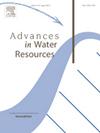Numerical investigation of multiphase flow through self-affine rough fractures
IF 4
2区 环境科学与生态学
Q1 WATER RESOURCES
引用次数: 0
Abstract
Multiphase flow through fractures has great significance in subsurface energy recovery and gas storage applications. Different fracture and flow properties affect flow through a fracture which is difficult to control in laboratory experiments. Here, we perform lattice Boltzmann simulations in an ensemble of synthetically generated fractures. Drainage simulations are performed at different capillary numbers, wettability, and viscosity ratios. We track the invading front and quantify breakthrough saturations and show that roughness and wettability have a strong effect on fluid invasion through a complex fracture. Invading a more viscous fluid results in more stable displacement regardless of the capillary number while at very low capillary numbers, fluid migration is dependent on the inherent structure of the fracture. We develop a fluid displacement phase diagram in a single rough fracture and compare our results from that in the literature. Finally, we extend the phase diagrams across multiple fractures and demonstrate the importance of natural fracture features of roughness and wettability in identifying stable versus unstable displacement regimes during multiphase flow through rough fractures. Our work presents an end-to-end numerical pathway for testing on experimental data and expanding numerical data sets for testing combinations of different physical phenomenon and make valuable predictions on fluid flow through rough fractures.
自仿射粗糙裂缝多相流的数值研究
裂缝多相流在地下能量回收和储气应用中具有重要意义。不同的裂缝和流动特性会影响通过裂缝的流动,这在实验室实验中是难以控制的。在这里,我们在合成裂缝的集合中进行了晶格玻尔兹曼模拟。在不同的毛细管数、润湿性和粘度比下进行排水模拟。我们跟踪了侵入前沿,量化了突破饱和度,发现粗糙度和润湿性对流体通过复杂裂缝侵入有很强的影响。无论毛细管数多少,侵入黏性越强的流体会导致更稳定的位移,而在毛细管数很低的情况下,流体的运移取决于裂缝的固有结构。我们开发了一个单一粗裂缝的流体位移相图,并将我们的结果与文献中的结果进行了比较。最后,我们将相图扩展到多个裂缝,并证明了天然裂缝的粗糙度和润湿性特征在识别多相流通过粗糙裂缝时的稳定与不稳定驱替机制中的重要性。我们的工作为实验数据的测试提供了端到端的数值途径,并扩展了用于测试不同物理现象组合的数值数据集,并对粗糙裂缝中的流体流动进行了有价值的预测。
本文章由计算机程序翻译,如有差异,请以英文原文为准。
求助全文
约1分钟内获得全文
求助全文
来源期刊

Advances in Water Resources
环境科学-水资源
CiteScore
9.40
自引率
6.40%
发文量
171
审稿时长
36 days
期刊介绍:
Advances in Water Resources provides a forum for the presentation of fundamental scientific advances in the understanding of water resources systems. The scope of Advances in Water Resources includes any combination of theoretical, computational, and experimental approaches used to advance fundamental understanding of surface or subsurface water resources systems or the interaction of these systems with the atmosphere, geosphere, biosphere, and human societies. Manuscripts involving case studies that do not attempt to reach broader conclusions, research on engineering design, applied hydraulics, or water quality and treatment, as well as applications of existing knowledge that do not advance fundamental understanding of hydrological processes, are not appropriate for Advances in Water Resources.
Examples of appropriate topical areas that will be considered include the following:
• Surface and subsurface hydrology
• Hydrometeorology
• Environmental fluid dynamics
• Ecohydrology and ecohydrodynamics
• Multiphase transport phenomena in porous media
• Fluid flow and species transport and reaction processes
 求助内容:
求助内容: 应助结果提醒方式:
应助结果提醒方式:


